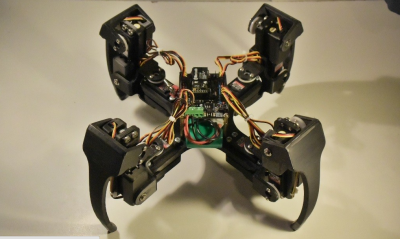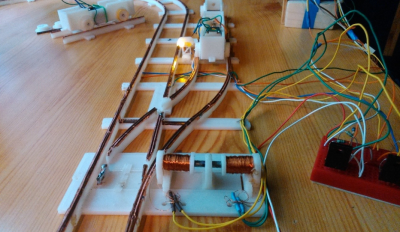If you can’t tell, we’re on a roll with 3D printers and printed projects this month. So far, we’ve covered printers, and simple functional 3D prints. This week we’re taking a look at some of the awesome complex 3D printed projects on Hackaday.io.
Complex 3D printed projects are things like robots, quadcopters, satellite tracking systems, and more. So let’s jump in and look at some of the best complex 3D printed projects on Hackaday.io!
 We start with [Alberto] and Dtto v1.0 Modular Robot. Dtto is [Alberto’s] entry in the 2016 Hackaday Prize. Inspired by Bruce Lee’s famous water quote, Dtto is a modular snake-like robot. Each section of Dtto is a double hinged joint. When two sections come together, magnets help them align. A servo controlled latch solidly docks the sections, which then work in unison. Dtto can connect and separate segments autonomously – no human required. [Alberto] sees applications for a robot like [Dtto] in search and rescue and space operations.
We start with [Alberto] and Dtto v1.0 Modular Robot. Dtto is [Alberto’s] entry in the 2016 Hackaday Prize. Inspired by Bruce Lee’s famous water quote, Dtto is a modular snake-like robot. Each section of Dtto is a double hinged joint. When two sections come together, magnets help them align. A servo controlled latch solidly docks the sections, which then work in unison. Dtto can connect and separate segments autonomously – no human required. [Alberto] sees applications for a robot like [Dtto] in search and rescue and space operations.
Next up is [Szabolcs Lőrincz] with Broke Hackers’ Model Railway. Anyone who’s read Steven Levy’s classic book ‘Hackers’ knows that model trains and hardware hacking go hand in hand. Unfortunately, model trains have gotten prohibitively expensive. Broke hackers’ model railway is the perfect solution. Nearly every part is 3D printed. The tracks are 3D printed sections with copper tape conductors. The locomotive has a 3D printed frame. Automated track switches use hand wound coils on 3D printed bobbins. This isn’t a dumb railway either – a Raspberry Pi controls the action, making sure the trains stay on time.
 Next we have [Rob] with Quadrup3D, his 3D printed quadruped robot. Quadrup3D uses 12 beefy R/C style servos to move its four legs. An Arduino with a Bluetooth handles on-board processing. This robot is built from 25 individual 3D printed parts. From the center frame to the legs, just about every major structural piece has been spit out by an FDM desktop printer. [Rob] uses his SpaceMouse Pro as a remote control unit. A laptop processes commands from the mouse and sends them to the robot. Using a control scheme like this allows [Rob] to quickly and easily experiment with different gaits and stances for his four legged friend.
Next we have [Rob] with Quadrup3D, his 3D printed quadruped robot. Quadrup3D uses 12 beefy R/C style servos to move its four legs. An Arduino with a Bluetooth handles on-board processing. This robot is built from 25 individual 3D printed parts. From the center frame to the legs, just about every major structural piece has been spit out by an FDM desktop printer. [Rob] uses his SpaceMouse Pro as a remote control unit. A laptop processes commands from the mouse and sends them to the robot. Using a control scheme like this allows [Rob] to quickly and easily experiment with different gaits and stances for his four legged friend.
 Finally we have [tlankford01] with LOKI 4G (Locate Observe Krack Isolate) 4th Gen. Who says you can’t 3D print your own drone? LOKI uses 3D printed parts for most of its major components. Carbon fiber rods act as the quad’s spine. Riding on these rods are 3D printed propeller guards, battery holder, and electronic enclosures. One of the most interesting parts is the 3D printed gimbal, used to stabilize aerial video. LOKI was used as a test mule for Project ICARUS, [tlankford01’s] poacher hunting 3D printed fixed wing drone.
Finally we have [tlankford01] with LOKI 4G (Locate Observe Krack Isolate) 4th Gen. Who says you can’t 3D print your own drone? LOKI uses 3D printed parts for most of its major components. Carbon fiber rods act as the quad’s spine. Riding on these rods are 3D printed propeller guards, battery holder, and electronic enclosures. One of the most interesting parts is the 3D printed gimbal, used to stabilize aerial video. LOKI was used as a test mule for Project ICARUS, [tlankford01’s] poacher hunting 3D printed fixed wing drone.
If you want to see more awesome complex 3D printed projects, check out our new complex 3D printed projects list! If I missed your project, don’t be shy, just drop me a message on Hackaday.io. That’s it for this week’s Hacklet. As always, see you next week. Same hack time, same hack channel, bringing you the best of Hackaday.io!


















3D printed model rail road?!..I know a kid (me) who 25 years ago would have sequestered my self in to the garage for a solid year had that tech been available. I would have come out a hermit, long child beard, surrounded by an entire empire of rail roads, cities and fictional printed people, all named Clarence…even the women.
I’m not convinced printing the track is something I would try, but bridges, buildings, and unusual rail cars are where 3D printing can really excel.
Some little hacker is going to do that and grow up to be just like you. The best thing we can do is try and teach the next generation and the circle is complete.
I’m not convinced that it couldn’t happen to an older Clarence as well.
It’s got me thinking of how to make the tracks a better way.
I was thinking of a slot in the middle of the track rail that you could put flat tin strips into. Perhaps you could serrate the bottom edge of the tin strip and have some silver wire at the bottom. Then at least some of the serration would make contact with the silver wire and I am hoping that silver oxide on the wire is conductive enough for the that train to run and scrape away oxide with vibration. This may work with a higher voltage like 12 Volts so that the resistance of the silver oxide doesn’t have as big an impact.
Electroplate those tracks possibly. Could be fun!
https://hackaday.com/2012/10/14/diy-tin-plating-for-bus-bars/
I’ve never dealt with model trains so take my suggestion with a grain of salt. I know it says ‘broke hackers’ railroad but you have a 3D printer so…….Gold plated rails. And chrome everything!
.
Train build looks very good!
I love women named Clarence (except the ones with Adam’s apples, avoid them), so if you have a 3D printer why don’t you give this a try?
https://xkcd.com/878/
Someone should have posted this by now. I’m ashamed of all of you. ;)
HaD to share –
http://imgs.xkcd.com/comics/model_rail.png
Link missing?
“Next we have [Rob] with Quadrup3D, his 3D printed quadruped robot. Quadrup3D uses 12 beefy R/C style servos to move its four legs. An Arduino with a Bluetooth handles on-board processing. This robot is built from 25 individual 3D printed parts. From the center frame to the legs, just about every major structural piece has been spit out by an FDM desktop printer. [Rob] uses his SpaceMouse Pro as a remote control unit. A laptop processes commands from the mouse and sends them to the robot. Using a control scheme like this allows [Rob] to quickly and easily experiment with different gaits and stances for his four legged friend.”
Fixed! Good catch. One thing I do with the hacklet is to link the images to the Hackaday.io projects, so if if a missed link ever gets through, the image should take you there.
That Ditto robot looks remarkably like what a group of japanese did some years ago. I always wanted to reproduce that, there was no 3D printers at the time, I still have some half-cut housings. The japanese had a magnetic/spring loaded system to attach the modules to another, though. Nice done !
Exactly! I made this robot to study the possibilities of 3D printed modular robots. This robot is inspired by the M-TRAN III, of the AIST, Japan. The spring loaded magnets were on the first version of the MTRAN, but now in the last model they have mechanical conectors. Feel free to join the project! :)